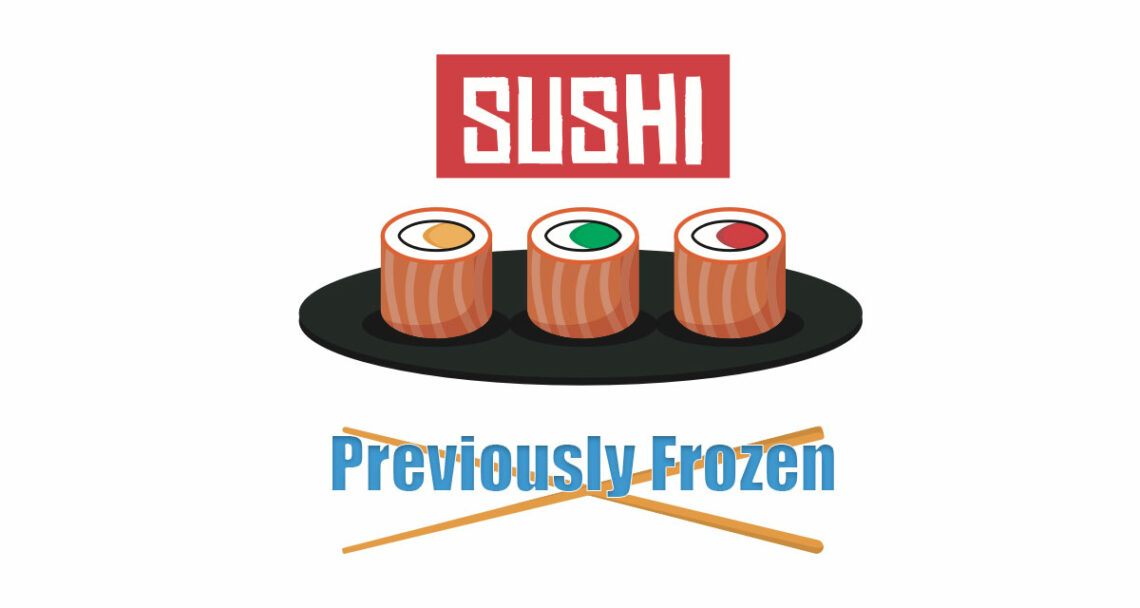In general fish has to be frozen for at least 15 hours in the US before being eaten raw to kill parasites according to the FDA (see details above). However, these rules don’t apply to all fish. Still, most “fresh fish” that is “sushi grade” has actually been frozen first in practice. This does have a slight impact on taste, but more importantly it ensures against parasites.
Most Sushi is Previously Frozen fact

Understanding Sushi Grade Fish – Is Sushi Frozen?
Most types of fish eaten raw have to be frozen to kill parasites before being served in the US according to the FDA. Meanwhile, “sushi grade” is fish that can be eaten raw. So most sushi grade fish is previously frozen in the US.[1][2][3][4][5]
Even outside of the US, other regions like the EU have similar rules or practices.
With that said, not every type of fish eaten raw is frozen first. In general some larger fishes like large Tuna and Salmon can be eaten without being frozen first depending on the region.
The overarching theme here is that freezing fish helps to kill parasites, so in fish that have a higher risk of parasites, freezing the fish first makes it suitable for eating raw, and the fish that is most suitable for eating raw is “sushi grade.”
FACT: The FDA has specific rules for freezing fish that would be served raw in the US. To be served raw, sushi has to be frozen at -31 degrees Fahrenheit for at least 15 hours according to the FDA Food Code 2017 [PDF] (see details below). Logically then, “sushi-grade” fish is fish that has been “frozen at -31 degrees Fahrenheit for at least 15 hours,” thus making it suitable to eat raw.
FACT: “Sushi” is sort of a catch all term for a family of dishes that often contain raw fish. Maki-sushi is made into a roll using some kind of a wrapper (typically nori, which is dried seaweed), nigiri-sushi sits on rice, and sashimi is sliced raw meat without rice. Sushi doesn’t have to contain raw fish, but all raw fish should be “sushi grade.”
What is Sushi Grade Fish?From Page 89 of the FDA Food code: Freezing 3-402.11 Parasite Destruction. (A) Except as specified in ¶ (B) of this section, before service or sale in READY-TO-EAT form, raw, raw-marinated, partially cooked, or marinated-partially cooked FISH shall be: (1) Frozen and stored at a temperature of -20°C (-4°F) or below for a minimum of 168 hours (7 days) in a freezer; P (2) Frozen at -35°C (-31°F) or below until solid and stored at -35°C (-31°F) or below for a minimum of 15 hours; P or (3) Frozen at -35°C (-31°F) or below until solid and stored at -20°C (-4°F) or below for a minimum of 24 hours. P (B) Paragraph (A) of this section does not apply to: (1) MOLLUSCAN SHELLFISH; (2) A scallop product consisting only of the shucked adductor muscle; (3) Tuna of the species Thunnus alalunga, Thunnus albacares (Yellowfin tuna), Thunnus atlanticus, Thunnus maccoyii (Bluefin tuna, Southern), Thunnus obesus (Bigeye tuna), or Thunnus thynnus (Bluefin tuna, Northern); or 89 (4) Aquacultured FISH, such as salmon, that: (a) If raised in open water, are raised in net-pens, or (b) Are raised in land-based operations such as ponds or tanks, and (c) Are fed formulated feed, such as pellets, that contains no live parasites infective to the aquacultured FISH. (5) FISH eggs that have been removed from the skein and rinsed.
- FDA Food Code 2017 [PDF]. Page 89.
- Selecting and Serving Fresh and Frozen Seafood Safely. FDA.Gov.
- Sushi Fresh From the Deep . . . the Deep Freeze. NyTimes.com.
- There’s A Good Chance Your Sushi Was Made With Previously Frozen Fish. HuffPost.com.
- You can now Eat raw Salmon…SAFELY!!! Fishmongers…read on!!! LearnHowtoMakeSushi.com.

jefbf Supports this as a Fact.
yes but only tesco sushi, good sushi is never frozen – disgusting !